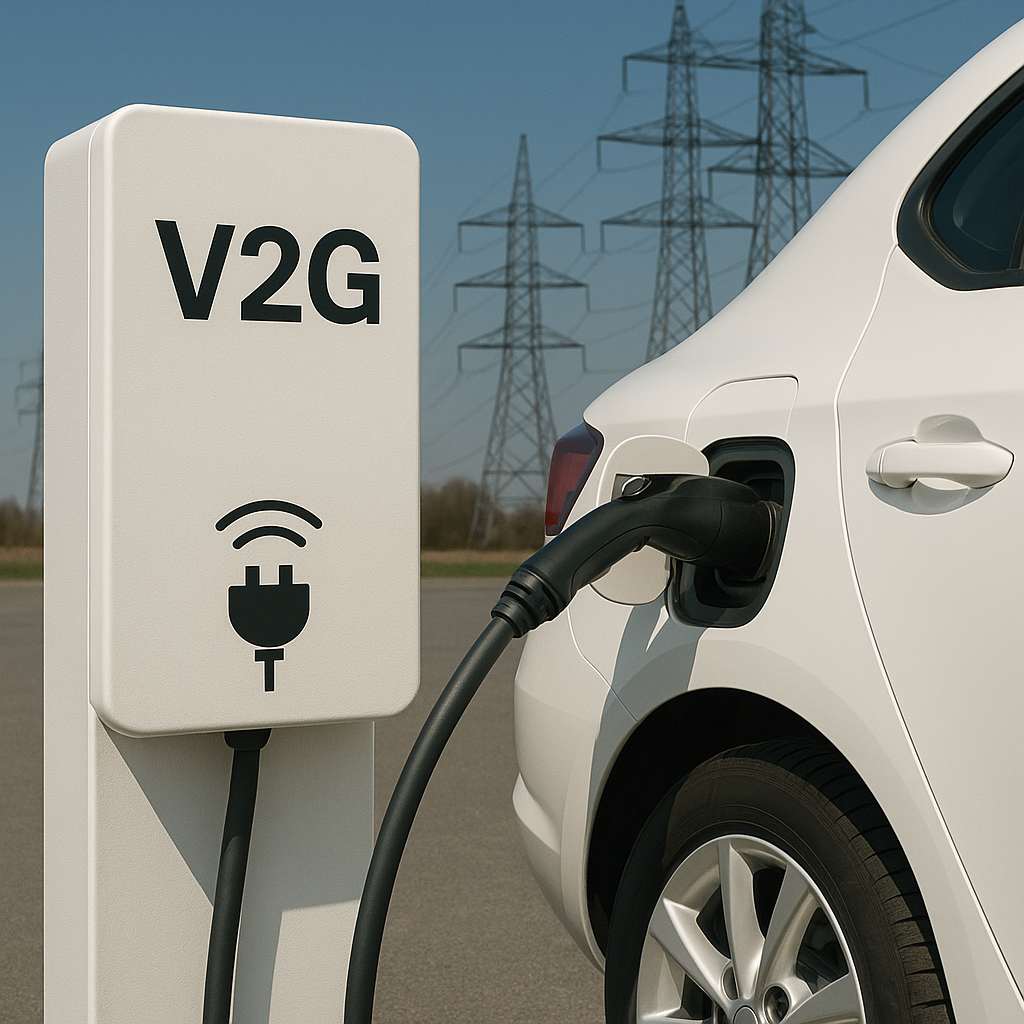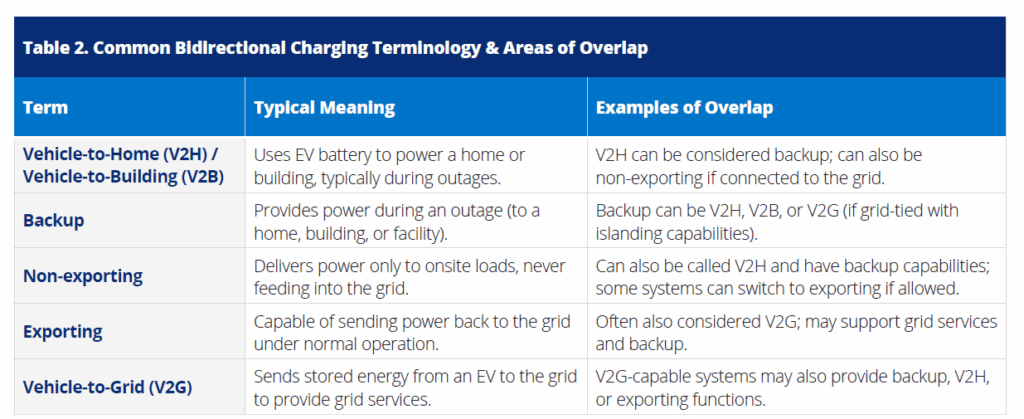
November 4, 2025
Report: Interconnection Guidance for Residential Bidirectional EV Charging
Publication Date: September 2025
Authors: Brittany Blair and Garrett Fitzgerald, Smart Electric Power Alliance (SEPA)
As automakers roll out more bidirectional-capable electric vehicles and homeowners begin asking how to connect them, confusion has mounted about what’s required to safely and legally interconnect these systems. Regulators, utilities, and customers have lacked clear, consistent rules distinguishing when a system must go through a formal interconnection process versus a simpler energization pathway.
The Smart Electric Power Alliance’s (SEPA) new report, Interconnection Guidance for Residential Bidirectional EV Charging, cuts through that confusion. Drawing on working sessions with ten utilities and two industry workshops, the September 2025 publication provides a utility-informed roadmap for regulators preparing for the coming wave of residential bidirectional charging.
Why This Report Matters
Until now, the absence of standardized terminology and pathways has led to inconsistent treatment of bidirectional EV systems. Some customers have been allowed to energize their chargers under load-only rules, while others have faced months-long interconnection reviews. Utilities have also struggled with how to classify systems that operate only during outages versus those that can export power during normal grid conditions.
SEPA’s report directly addresses this uncertainty by:
- Defining key bidirectional charging configurations and their grid implications.
- Distinguishing energization (load-only or backup systems) from interconnection (grid-connected or exporting systems).
- Documenting early state commission actions that illustrate workable regulatory approaches.
The analysis clarifies what’s required to balance grid safety, customer convenience, and program scalability, helping prevent the fragmented regulatory landscape that slowed earlier distributed energy resource (DER) adoption.
How the Report Is Organized
SEPA structures the report around two major themes, summarized in Table 1 of the report:
- Accurate Terminology Matters – Provides clear definitions for the full range of bidirectional charging use cases (Vehicle-to-Load, Vehicle-to-Home, Vehicle-to-Grid, etc.), explains inverter placement (on-board vs. off-board), and recommends common language for regulators and utilities.
- Regulatory Oversight of Energization vs. Interconnection – Explains how each configuration should be treated under existing rules, reviews early state precedents (California, Maryland, Massachusetts, Michigan, and New York), and outlines the safety and programmatic implications of different pathways.
Each section is supported by figures showing technical configurations and flow diagrams, plus Table E1 and Table 3 summarizing state regulatory actions.
To help clarify the often-confusing terminology that utilities, manufacturers, and customers use to describe bidirectional charging, SEPA includes Table 2, which maps the most common terms, such as Vehicle-to-Home, backup, non-exporting, and Vehicle-to-Grid, and shows where these categories overlap. This table serves as a quick reference for regulators developing consistent definitions and determining when interconnection is required.

Source: SEPA (2025) Interconnection Guidance for Residential Bidirectional EV Charging.
The location of the inverter, either on the vehicle (V2G-AC) or in the charger or backup unit (V2G-DC), has major implications for interconnection. Most current residential bidirectional systems in the U.S. are V2G-DC, where the inverter is built into the charger and must be certified to standards such as UL 1741 SB. In these cases, the interconnection process focuses on the stationary equipment, similar to how utilities review home battery storage systems.
Looking ahead, automakers are expected to move toward on-board inverters (V2G-AC) that can export AC power directly from the vehicle. These mobile inverters will likely fall under a new certification framework, UL 1741 Supplement C (SC), and could simplify installation for customers, but they will also require regulators to rethink how interconnection is handled. SEPA recommends that commissions plan for both DC and AC pathways, ensuring interconnection rules remain flexible enough to accommodate the shift toward on-board inverters without creating new bottlenecks or safety gaps.
Key Recommendations
Building on utility input and lessons from early state experiences, SEPA distills its findings into a focused set of near-term actions that regulators and utilities can take to prepare for wider adoption of residential bidirectional charging. The report emphasizes that acting now, while market penetration remains low, will help avoid the confusion, delays, and inconsistent treatment that characterized earlier distributed energy resource rollouts. These recommendations are intended to create a shared foundation of definitions, rules, and processes that ensure safety, improve customer experience, and enable EVs to serve as flexible grid assets.
The SEPA report identifies six near-term actions for regulators and utilities:
- Codify Definitions – Establish statewide definitions for bidirectional configurations (V2H, V2G, exporting, non-exporting) so that utilities, installers, and customers use consistent terms.
- Support Utility Pilots – Conduct program pilots to evaluate technology performance, customer interest, and grid impacts under real-world conditions.
- Update Rules for Multiple Pathways – Explicitly include bidirectional charging configurations and use cases in both energization and interconnection rules.
- Create Adaptable Interconnection Pathways – Develop adaptable processes that can evolve with changing technologies and standards, including forthcoming UL 1741 SC requirements for on-board (V2G-AC) systems.
- Align Interconnection Fees with Actual Costs – Ensure fees reflect processing and study costs comparable to other DERs, such as stationary storage.
- Advance Rate and Market Reforms – Enable bidirectional systems to participate in grid-service programs, such as demand response or virtual power plants, with transparent and fair compensation.
The Case for Requiring Interconnection for All Bidirectional Systems
SEPA’s report acknowledges that while utilities are increasingly concerned about inadvertent exports and backfeeding, a universal interconnection requirement for all bidirectional systems is best viewed as a longer-term objective, not an immediate necessity. Backfeeding can occur if systems are installed incorrectly or reconfigured through software updates, posing potential safety risks to lineworkers and the distribution grid. For now, SEPA notes that maintaining clear rules for energization pathways, especially for non-parallel, backup-only systems, can help customers safely access resilience benefits while utilities refine their interconnection processes.
In the longer term, however, SEPA points out that requiring all bidirectional systems to interconnect would provide consistent oversight and improve grid safety. Interconnection ensures that systems include safeguards like power control devices and transfer switches, use certified equipment, and comply with safety standards such as UL 1741 SB. It also gives utilities visibility into where systems are installed, helping to prevent unauthorized discharging and improving situational awareness across the grid.
From the customer perspective, completing interconnection during installation creates future flexibility and “pre-qualifies” the system for export-based programs. Customers who install bidirectional equipment but choose to operate only in V1G mode can still participate in demand response or managed charging programs without interconnection. However, if they later want to enable full bidirectional operation and export power to the grid—such as in virtual power plant or resiliency programs—having already completed interconnection avoids the need for costly retrofits and additional approvals. By addressing interconnection early, customers keep all future participation options open while still benefiting from V1G programs in the meantime.
Ultimately, SEPA frames universal interconnection as a goal to work toward as markets evolve and technologies standardize. In the near term, regulators can continue to rely on energization pathways for backup applications, provided safeguards against backfeeding are in place. Over time, as adoption grows and utilities gain experience, broader interconnection requirements can help integrate these systems safely and efficiently into grid operations.
The Broader Takeaway
SEPA emphasizes that regulators don’t need to start from scratch. Many lessons from rooftop solar and stationary storage apply directly to bidirectional EV systems, though the mobility of vehicles and their dual role as load and generation require new regulatory nuance. Acting now, while adoption remains modest, will:
- Prevent bottlenecks and inconsistent utility treatment later,
- Ensure customer systems are installed safely, and
- Unlock the full grid and resilience benefits of bidirectional EVs.
Interconnection policy, the report concludes, is no longer a technical footnote; it’s the foundation for transforming bidirectional charging from a promising idea into a scalable, reliable grid resource that positions millions of EVs to actively support the clean energy transition.